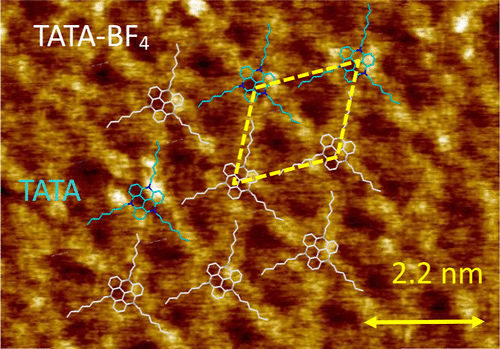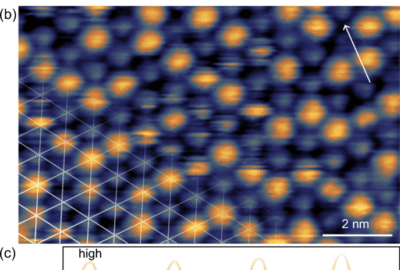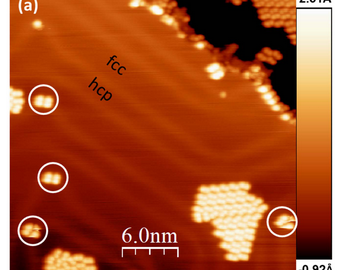publications, Réseau
Nonuniform STM Contrast of Self-Assembled Tri-n-octyl-triazatriangulenium Tetrafluoroborate on HOPG
We have assembled 4,8,12-tri-n-octyl-4,8,12-triazatrianguleniumtetrafluoroborate (TATA-BF4) on highly oriented pyrolytic graphite (HOPG) and have studied the structure and tunneling properties of this self-assembled monolayer (SAM) using scanning tunneling microscopy (STM) under ambient conditions. We show that the triazatriangulenium cations TATA(+) form hexagonally packed structures driven by the interaction between the aromatic core and the HOPG lattice, as evidenced by density functional theory (DFT) modeling. According to the DFT results, the three alkyl chains of the platform tend to follow the main crystallographic directions of HOPG, leading to a different STM appearance. The STM contrast of the SAM shows that the monolayer is formed by two types of species, namely, TATA(+) with BF4- counterions on top and without them. The cationic TATA(+) platform gives rise to a seemingly higher appearance than neutral TATA-BF4, in contrast to observations made on metallic substrates. The variation of the STM tunneling parameters does not change the relative difference of contrast, revealing the stability of both species on HOPG. DFT calculations show that TATA-BF4 on HOPG has sufficient binding energy to resist dissociation into TATA(+) and BF4-, which might occur under the action of the electric field in the tunneling gap during STM scanning.
Snegir, S; Dappe, YJ; Sysoiev, D; Huhn, T; Scheer, E; ACS Omega 2023, 8, 41, 38766–38772, doi
Comments are closed






